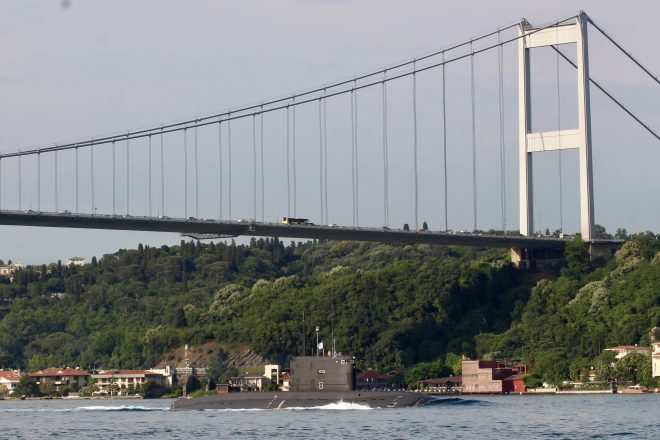Russian diesel-electric attack submarine Rostov-on-Don was sunk Friday in Sevastapol, international news outlets reported.
The BBC and Reuters, citing Ukrainian general staff online postings, said a missile attack sank the Kilo-class attack boat while it was at anchor in the Black Sea port.
This would be the second successful missile attack on the submarine in 11 months.
Then, the Ukrainian defense ministry reported the attack sank the boat, which proved false. Although heavily damaged in that attack, the sub was repaired and may have been undergoing service trials.
Russian government and military sources did not confirm the most recent attack.
The Ukrainian military also claims Friday’s attack “significantly damaged” four launchers attached to a Russian S-400 air defense system protecting the city on the Crimean peninsula. The S-400 is the Kremlin’s most advanced air defense system.
The Ukrainian defense ministry did not elaborate on the missiles it fired Friday or how the attack was carried out.
On June 24, the Russian Foreign Ministry said in a release, “the Kiev regime, with support from the United States and its satellites, committed yet another heinous terrorist crime against civilians in Russia by firing missiles at Sevastopol. For their terrorist attack, they specially chose a day – Holy Trinity Sunday – one of the most important holidays celebrated by the Russian Orthodox Church.”
The Kremlin said the missiles were American-made Army Tactical Missile System [ATACMS] guided by intelligence from United States satellites and a long-range reconnaissance drone.
Ukraine’s continuing sea drone and missile attacks caused Moscow to disperse most of the Black Sea Fleet to safer ports far from Crimea in southern Russia last year. Novorossik, one of Russia’s largest ports for the export of grain and oil, has been the destination of many the ships assigned to the fleet.
At least one-third of the 28 vessels assigned to it have been sunk or severely damaged. naval warfare experts told USNI News.
How safe those ports in southern Russia are from extended-range sea drone attacks is also open to question. The Ukrainian Navy boasted in July its advanced Sea Baby unmanned surface vessels could strike ships in that port.
Russia’s defense ministry reported destroying two Ukrainian naval drones in early July near Novorossik before they struck targets in the port or disrupted operations.
The Ukrainian defense ministry in a Facebook posting on Friday’s attack said, “”The destruction of ‘Rostov-on-Don‘ once again proves that there is no safe place for the Russian fleet in the Ukrainian territorial waters of the Black Sea.”
Although Rostov-on-Don was possibly sunk Friday, the Russian Black Sea Fleet has moved in the last two weeks to re-establish its presence in those waters in backstopping the ground campaign, particularly in the Donbas region of eastern Ukraine.
Ukrainian Navy spokesman Capt. Dmytro Pletenchuk, said, “For the first time, the enemy has launched three submarines that carry cruise missiles at once. In fact, these are all available in the Azov-Black Sea region. Sometimes, the Black Sea Fleet is called a submarine fleet. Now it is true.”
The submarines would likely operate in conjunction with guided missile frigates also recently reported sailing in the Black Sea.
The Black Sea Fleet did not participate in the Russian Navy’s largest worldwide exercise in years that began in late July. The exercises involve 20,000 sailors and marines and 300 surface ships and boats, submarines and support vessels. Fifty aircraft are also involved in the drills. They are being conducted from the Arctic to the Atlantic to the Indo-Pacific.
“Units and formations of the Russian Navy have begun conducting planned exercises in the operational zones of the Northern, Pacific and Baltic Fleets, as well as in the area of responsibility of the Caspian Flotilla,” the Russian defense ministry said.
It is unclear whether the stepped joint operations between Russian and Chinese navies near Japan and the Philippines are part of the much larger exercise.
The Kremlin took control of Crimea in 2014, saying it was historically Russian and its citizens welcomed the takeover in a rigged referendum. Maintaining a Russian naval presence in Sevastopol dates back to the reign of Catherine the Great in 1783. Protecting the base was one of the reasons Moscow cited for the takeover.

